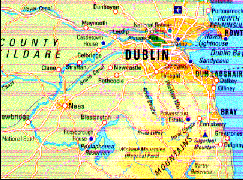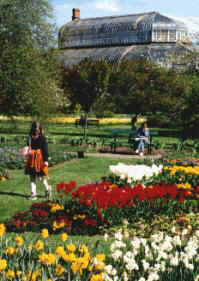
Parks and Rivers
1.
The River Liffey

|
Halfpenny Bridge by Stacey |
O'Connell St. Bridge |
2. The Phoenix Park

Wellington Monument |
The Phoenix Park is situated north of the River Liffey about 3 km from O'Connell Street. It is enclosed within seven miles of stone walls and measures 708 hectares (1752 acres). The park was walled in 1672 to impress King Charles 11. The park is the biggest walled park in Europe. The homes of the President and the American Ambassador to Ireland are there. Dublin Zoo, the second oldest zoo in the world, is also there. There are fallow deer, rabbits foxes and lots of trees. People have picnics and go to the playground. There are football matches and polo and cricket and car racing and you can go horse riding there.
|
Mrs. Johnston and 6th class had tea with the President |
3.
St. Stephen's Green
|
Bandstand and lake at St. Stephen's Green |
St.
Stephen's Green is a lovely park at the top of Grafton Street.
Originally it was used for grazing animals.
In 1663 this park was enclosed by a wall and in 1817 Sir Arthur Guinness
paid for it to be turned into a park for the people.
It has lakes and lawns and colourful flower beds and trees and a
playground. There are lots of ducks
and a few squirrels.
4.The Botanic Gardens
 |
 |
The Botanic Gardens is near our school and classes often go there to study the plants, to walk and to sketch. The River Tolka flows through the gardens and you can see grey squirrels and ducks. There is a rose garden and there are huge old trees. Plants from warm countries grow in glasshouses. The Botanic Gardens were opened in 1795 by the Royal Dublin Society. People then collected plants all over the world and planted them in Botanic Gardens to study them. We like to visit the Botanic Gardens.